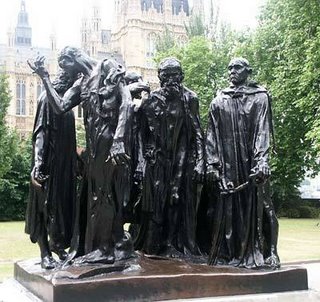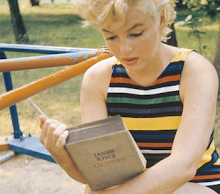My Burghers of Calais

Standing outside The
Staring up at the small, disfigured and contorted bodies and formidable melting doors in front of me I stammered, 'I think it's The Gates of Hell'. I sort of knew it was, but I couldn't really be sure it was in front of me. I was meant to have an overwhelming reaction to it, but in the bright sunshine of the dazzling courtyard of the Academy, it looked a bit too pure, and not molten enough to be truly terrifying. With people wrapped up in their woollen coats and cashmere scarves hugging and kissing eachother hello before turning back to the cast in serious contemplation it looked rather sanitised.
The
Fortunately a school party of, I think, 9-10 year olds, were being guided through the exhibiton, split into small groups of two or three students and taken through all the major works in the Academy by their teachers. They weren't standing earnestly stroking their chins, considering the merits of bronze over marble or terracota, or musing about the successful translation of the aims of Impressionism into three-dimensional forms. They were shrieking and pointing at Balzac's big fat paunch and the profusion of visible genitalia. They were gasping at their guide's sensational account of the discovery of the adulterous Paulo and Francesca and shuddering at tales of their torment in Hell. They weren't pacing around The Kiss in silent reverence, but stewing over the fate awaiting these two people snogging and anxiously asking 'But, Miss, if he didn't carve it, why is it a Rodin?' They dismissed the 'big' marble Kiss as a bit of a cheat, and 'showing off', but stood patiently around the smaller terracota version, nodding excitedly at tall tales of murder and adultery, before asking why such a horrible story would have made such a pretty sculpture.
The Burghers of Calais is my favourite sculpture of all time. Fortunately I can see it any time I like in
The children were fascinated by the fact that on approaching the sculpture, some of the figures were partially obscured by each other, and that to really see the work, you had to quite literally, walk around the entire thing and meet each one on their own terms. All of the children I listened to focused immediately on the two figures on the far right if you approach the sculpture head on. They were mystified by the calm but clearly plaintive expression on the figure in the foreground (Jean d'Aire), a mix of defiant determination and solemn resignation on his face. He was clearly very brave.
They all instinctively ran around him to the man behind him, face shielded, hands pressed against his skull in utter despair (Andrieu d'Andres). He obviously didn't want to be anybody's hero anymore and he didn't want to die. One boy said that he looked like he was asking 'Why?'. His friend piped up; 'Or, why me?'
They all thought Pierre de Wiessant (far left, arm outstretched) looked sad, like he had been crying or maybe praying. One remarked how, if you stand in front of
They appreciated the figure behind him with arms outstretched and mouth open (Jean de Fiennes) and his apparent kind attempts to comfort his friends. He was a nice man. Jacques de Wiessant looked 'scared' and 'not sure' about what was going to happen. As a figure he seemed to naturally fade into the background, and as if he was trying to block out the others around him.
They thought the sculpture's almost central figure, Eustache de Saint-Pierre looked tired and old. One girl said she thought he looked ready to die.
And all they all noticed they were carrying big keys. And that they had big hands and big feet. Most of them agreed with Rodin that it would have been much more boring if all the figures had been placed in a pyramid formation, or, as one girl put it, they might have looked like cheerleaders. Which would not have been very good.
The Burghers of Calais has been my favourite sculpture for six years now. And perhaps for the first time in a good four years, on Monday I looked at it properly again. It’s still my favourite sculpture – but now I remember why.


0 Comments:
Post a Comment
Subscribe to Post Comments [Atom]
<< Home